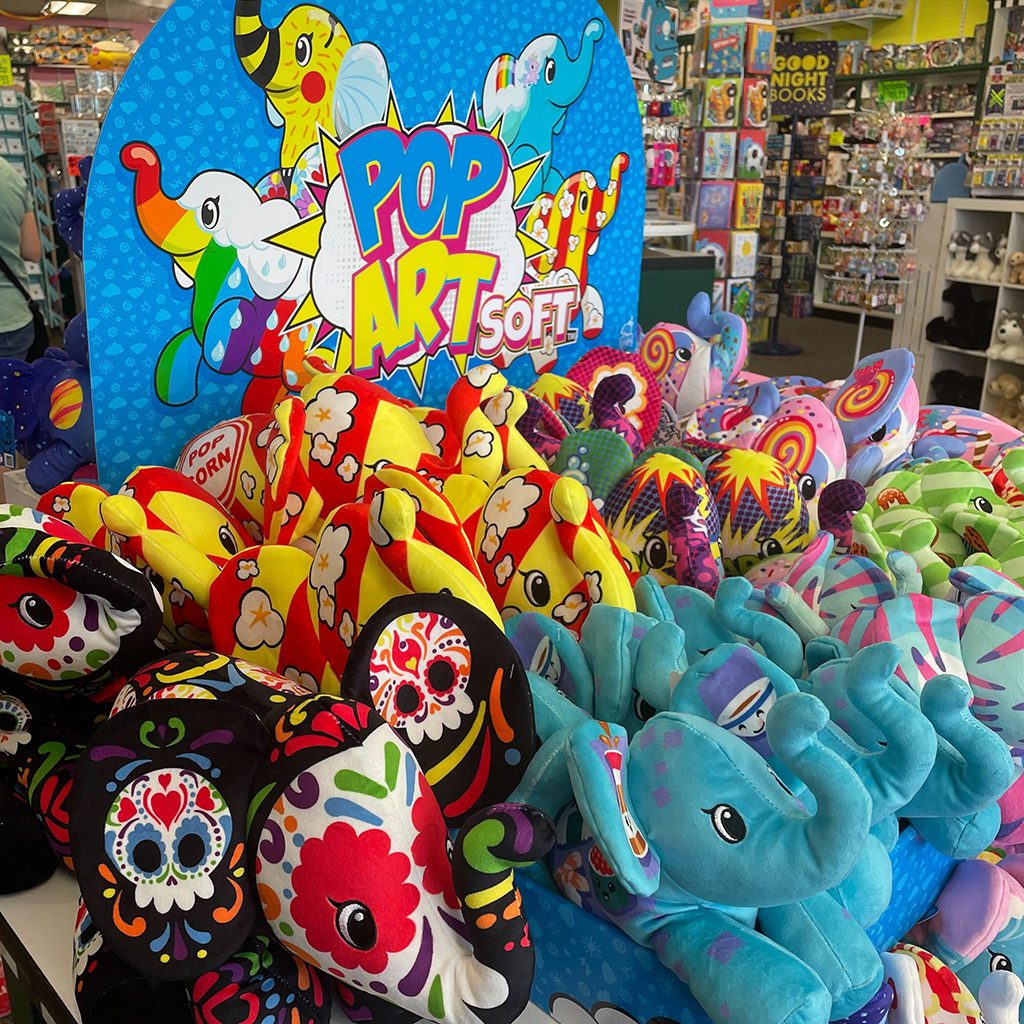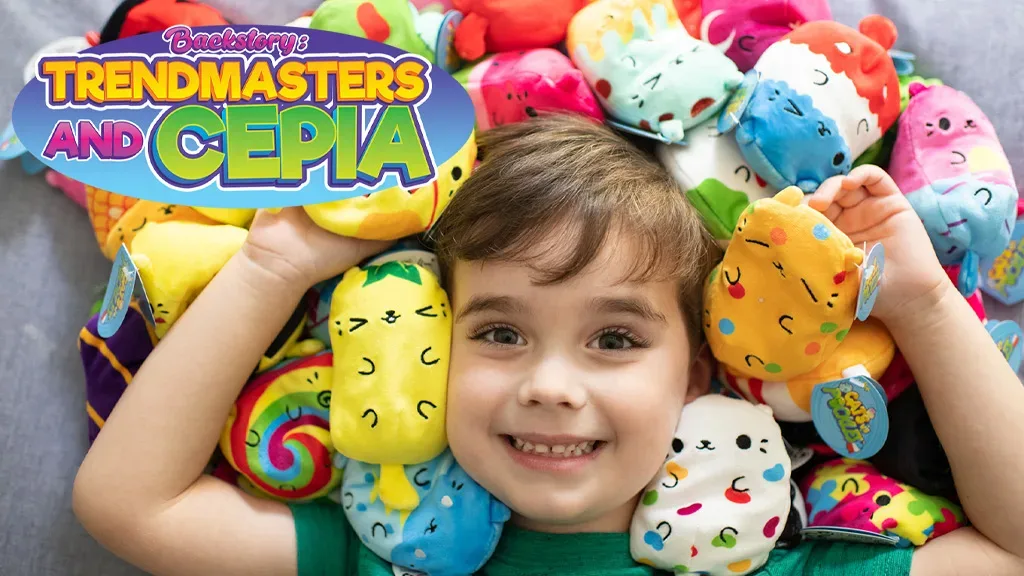Just like superheroes, everyone has an origin story. The same can be said of toy companies, either created because of a specific toy or a passion for play — or as a phoenix rising from the ashes.
Trendmasters’ story isn’t necessarily one of being absorbed like Tonka was by Hasbro or American Girl by Mattel — it was gutted and born again. Playsets and action figures were traded for a zoo full of plush cats, dogs, hamsters, elephants, sea turtles, and bears.
Now under the name Cepia, toys that could’ve been gendered are now inclusive, lending themselves to a peaceful coexistence. After 20 years in business, the company has set its sights on the collectibles market with what it calls the “versus” universe.
COMPETING AGAINST THE MAJORS
While the toy industry was dominated by major rivals from both coasts, a St. Louis company named Trendmasters was able to carve out its own niche starting in 1989. The release of Polly Pocket that same year made the small doll category something to contend with on store shelves. Barbie was starting to stale and the toy industry was looking for something new and novel. Trendmasters struck gold with its Starcastles line in 1995, long before Disney would dominate the princess category in the toy department.
Designed for kids ages 4 and up, the dripping-in-glitter Starcastles gave playtime new reign over kids’ imaginations and helped let girls capture the magic for themselves. Accompanying each playset was a 1-inch-tall princess figurine and a key to the castle. As an in-house brand, no licensing was required and no royalties had to be paid out.
First came the Magical Tea Party Playset, which featured an actual working tea set. It turned out to be the best-selling item in the entire line. One thing that set the toys apart from other comparable items on store shelves was that all of the castles — more than 80 designs were done at the line’s end — included a working component as a surprise factor to keep them engaged.
Joe McGowan, former director of product design at Trendmasters, says, “[Starcastles] gave little girls the play patterns that they were really looking for: a fantasy world of princesses and fairies and princes and frogs and everything that comes with the story.” Russ Hornsby, CEO and co-founder of the company, explains, “This was not about going after small sets. We started off with the concept that all little girls love castles and all little girls love tea parties.”
ROYAL TREATMENT
During Starcastles’ seven-year run, others in the industry took note. According to Hornsby, a Mattel executive once conceded that Trendmasters took a 55-60% market share from them in the category. “We took things Mattel would price at $20 and we were selling the stuff at $10,” he says.
Just one year before Starcastles hit the market, the company was awarded the license for Godzilla in 1994 from Toho Co. Ltd. It was a short run of success, though, as the grandiose toy line produced for the underperforming 1998 Godzilla film resulted in retailers refusing figures for its animated TV spinoff after unsold movie-related inventory clogged shelves.
Continuing in the “boys’ toys” direction, upon the 1998 broadcast of Voltron: The Third Dimension — the sequel to 1984’s Lion Force Voltron series set five years after the end of the series — the company reissued the Matchbox die-cast Lion Force Voltron with a few small changes to the mold and a whopping total of 17 weapons, in stark contrast to the original’s sword and shield. Other Trendmasters brands in the action aisle included Extreme Ghostbusters, Lost in Space, Casper, ID4: Independence Day, Mars Attacks, and more.
SALES POINT
By 2002, the company grew its business to $230 million in revenue, but a major shift was looming. Due to the events of September 11, 2001, and the resulting economic impact and consumer uncertainty, Trendmasters sold its intellectual property to Jakks Pacific in December 2002.
Chalk it up to eagerness or necessity, but, according to Joel Bennett, former chief financial officer of Jakks Pacific, the deal was done in just six to eight weeks. “[Jakks] had several innovations, proprietary brands, and segments that were a good fit [with Trendmasters],” Bennett says. “It was complementary as Jakks was looking to diversify the company’s product offerings in other categories.”
While the terms of the deal were not disclosed, the Los Angeles Times noted that “toy industry experts said the financially troubled Trendmasters had a number of suitors and probably sold for about $25 million.”
At the time, Jakks’ President and Co-founder Stephen Berman told the Los Angeles Times, “A lot of the parts fit very well with our company and they are a well-known brand with retailers. Many retailers called us and complimented us on getting the deal done.”
A COMPANY REBORN
After the sale, Hornsby quickly pivoted to build another kingdom of his own: Cepia LLC. Officially opening its doors in 2002, this new company took a few years to find its footing, just like its predecessor. Pragmatic items paved the way for ZhuZhu Pets in 2009, Chinese for “little pig.”
These inexpensive robotic hamsters hit a high point recalling the success of Cabbage Patch dolls and Tickle Me Elmo. In 2011, the toy made its way onto Time’s All-Time 100 Greatest Toys list, and by 2012, Cepia sold more than 70 million ZhuZhu Pets, adding more than $2 billion in retail sales to the company’s coffers. Cepia retired the brand after only three years on shelves, but after demand didn’t let up, ZhuZhu Pets made their return to the market in 2015 along with a cartoon. In 2017, Cepia worked with Spin Master on a ZhuZhu Pets reboot with new products and accessories based on the TV series.
FEEL-INE FINE
It would take another species of animal and the advent of social media to start the company on the next leg of its journey. The original internet sensations are cat videos, especially the ones in which felines are frightened by cucumbers. How could that possibly become a toy line?
Even though the world had other plans in 2020, Cepia decided to launch Cats Vs Pickles, a line of super-soft bean-filled plush toys. Sans gender, the principle was simple per Cepia: “Cats are scared of pickles, but pickles just want love.” Cepia Chief Marketing Officer Laura Frerichs says, “Launching a brand during a pandemic is not for the faint of heart, but launching a brand like this one makes all the sense in the world. We decided to turn this into a story of inclusivity and acceptance and kind of a fun narrative. It’s something that’s really resonated with people across the board because, basically, everybody’s been a pickle at some time in their life.”
Richard Derr, president of the Franchise Advisory Council for Learning Express, was an early proponent of the toy. Instead of following the blind bag trend, he says, “Let’s fill this up and let kids pick what they want … Our pledge to them was we were giving input on design, what sold, what didn’t, what colors.” It wasn’t without a certain amount of trust on the part of Learning Express either. Derr continues, “We took the risk [along with them], set it off, gave them feedback … Not many companies listen to retailers and they have been the most attentive and really genuine about receiving feedback. They talk to my staff, they do Zooms, they look for colors, they look for trends, and they take that feedback seriously.”

PLUSH ON TAP
Leaning into the collectibles and blind bags phenomena, Cepia has expanded the “versus” universe to include Kittens Vs Gherkins, Dogs Vs Squirls, and, coming in January, Bears Vs Donuts.
Following a test run at Derr’s Learning Express store in Lake Zurich, Illinois this fall, Cepia’s next plush release, Pop Art Soft elephants, will go into wide release with an exclusive mass retail debut at Walmart in January. Described by Frerichs as “pop art meets plush,” the company aims to break elephants out of the nursery setting. The line will employ the same principle of beans and blind bags across three sizes — Mini, Mighty, and Mammoth — and sea turtles are coming ashore to join the zoo.
Lastly, to round out Cepia’s mentality of “it all belongs” — meaning kids can build out a whole world where each line can co-exist — the Pineapple Popcorn Show will complement next year’s offerings. Debuting in late spring, this Night at the Museum–esque show takes place at a mall food court and the figures will be bendable and poseable.
After 33 years at the helm of two successful toy companies, Hornsby finds happiness in the future but, at times, longs for the past. He says, “We moved on to a different world, but at Trendmasters, we were able to touch so many different things.”
This article was originally published in the 2022 Innovation & STEM issue of The Toy Book. Click here to read the full issue! Want to receive The Toy Book in print? Click here for subscription options!

